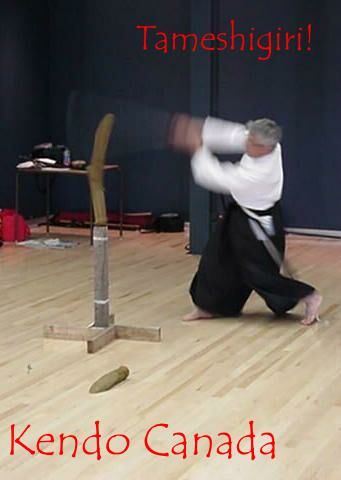

Kim Taylor
Copyright © Kim Taylor 2001. All rights
reserved.
In March, 2001 Mr. Goyo Ohmi (6dan kendo, 6dan iaido Canadian Kendo Federation) held a tameshigiri seminar at the Japanese Canadian Cultural Center in Toronto, Canada. The following is a report of an excellent introduction to tameshigiri. Fifteen to twenty students from many places in Southern Ontario attended the seminar and several seniors graciously donated the use of their shinken so that all could have their turn at the targets.
Ohmi sensei began the 4 hour seminar with a look at the design and theory of the Japanese sword. He pointed out the relevent parts, making specific mention of those involved in safety such as the mekugi (pegs) that hold the tsuka (hilt) and blade together. He discussed various swordsmen's ideas on the curvature of the blade and it's relationship to cutting.
A method for locating the monouchi (the area of contact on an ideal cut) was demonstrated, one holds the blade lightly and rests the side on a table edge. Now run the blade over the edge slowly toward the tip, at some point the curvature of the blade and the weight distribution will cause the blade to rotate to the edge downward position. Ideally this will happen about 4 to 8 inches back from the tip, if it does not the blade is "not Japanese" and won't cut well. By switching fittings on the hilt one can change the position of the monouchi and put it exactly where one wants it.
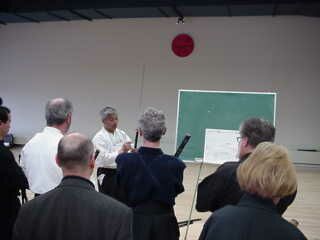
Ohmi sensei then went on to discuss how to appraise a blade. This was definitely not a lecture in sword collecting since the appraisal was concerned with whether or not the blade could withstand the shock of cutting. Various fatal and non fatal kizu (flaws) were outlined. A discussion of edge geometry was next, with the various shapes from "clam shell" (convex) to concave being described and the reason for each. The "clam shell" shape is the strongest edge and is perhaps not as suitable as others for modern cutting materials such as mats and newspaper, but is the only shape that should be used for straw or dry bamboo. A flat blade from shinogi to ha (ridgeline on the side of the blade to the edge) makes for a lighter blade and a better wedge shape to go through wet mats. A concave edge makes for a razor thin cutting surface and is good for single sheets of newsprint or even hanging thread, but is a very weak edge for heavier materials such as straw, dry bamboo or even mats.
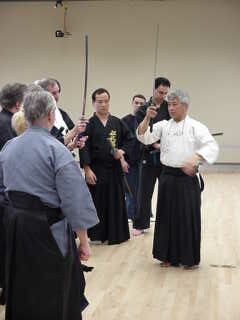
At this point Ohmi sensei made very clear the difference between a shinken used for tameshigiri (as sharp as possible) and one for iaido (which has the edge "taken off"). He gave us the method taught to him 30 years ago by Sakamoto sensei in Osaka, which is to lay the edge on a fine stone (4000 grit for example) and to draw it back along the stone two or three times using only the blade's weight. This will keep a sharp blade, but it won't be quite as likely to cut skin on a very light touch. When one wants to do some cutting, the edge is easily re-established.

Mr. Fred Kay then gave a presentation of sharpening techniques for Japanese tools and mentioned the difference between sharpening a chisel and sharpening a sword. He showed the difference between the hard and soft metals in a chisel, (where the hard edge is polished to a shinier finish than the supporting back), and the hard edge of the sword which, (mostly for reasons of aesthetics), is sharpened to a flatter finish than the softer backing material, (which is burnished to a higher polish). He also gave a quick description of Japanese water stones and why they are used for polishing the extremely hard edge. After admonishing all against polishing an antique national treasure by themselves and thus destroying a museum piece (and losing much potential profit), Mr. Kay showed us how one might put a cutting edge back on a tameshigiri blade.

Of course, any time one is using a sword to cut, one risks bending it. Here Mr. Kay demonstrates a method of straightening a particularly sharp bend. The blade is placed over two softwood block and a soft hammer is used to pound it straight. Other methods mentioned were to simply bend it over one's knee, and to use specialized tools to remove a twist down the blade.
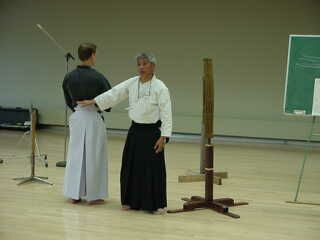
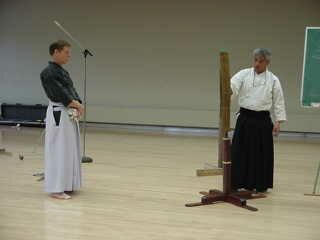
Next Ohmi sensei outlined what the "wet mat" tameshigiri target was supposed to represent, a cut through the lower back. In some cases the targets are made around a green bamboo shoot (no older than 3 years, and certainly not dry) representing the spine.


Many other materials beside mats were discussed as targets, for instance a hanging thread. If the edge of the sword isn't very sharp or the cut is too slow or is "chopped", this won't be cut. Similarly a single sheet of newsprint rolled into a tube about the size of a tameshigiri mat may be cut if the blade is very sharp and your attack angle is correct.

The students finally began swinging their blades in air, practicing the pulling cut that works best for tameshigiri, starting from feet together and stepping back as they cut through to make sure the blade slices and doesn't "hack" like an axe.
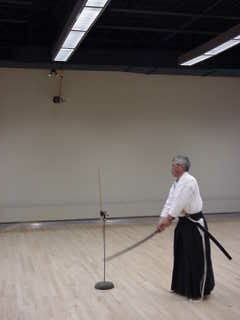
Small dry reeds were used next to make sure that the students could find the range to the target, and to check the angle of the cut which should be close to 45 degrees, any steeper and there is a risk of the blade glancing off and not cutting in. Shallower angles down to 90 degrees are fine for different cuts. Ohmi sensei also stressed at this point that one should always cut away from the forward knee since enthusiastic choppers have been known to chop into their knee or toe as they swing down to the floor.
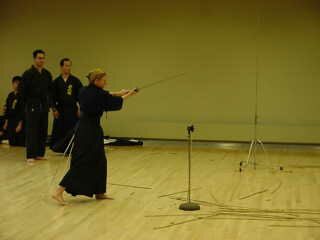
Many different angles of cut were tried on the reeds before moving on to the mats.
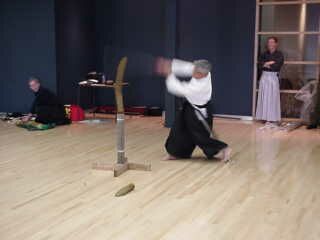
Eventually all those present were given a chance to cut up some mats. After the excellent introduction to tameshigiri everyone managed a few good cuts. One student who had started iaido only months before was cutting like a pro from his third swing at the mats. All that was required was to stop trying to swing like hitting a baseball and to allow the natural swing of the sword to do the work.

The battle finally over, all that was left was to remove the vanquished
and retire to the inn for sushi and beer.